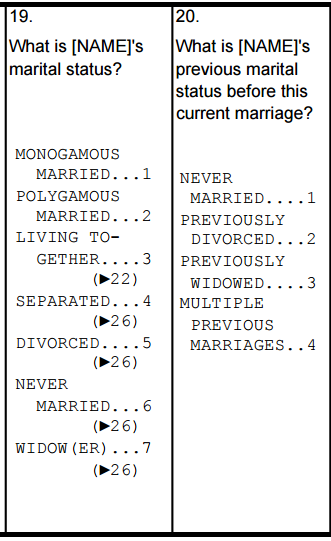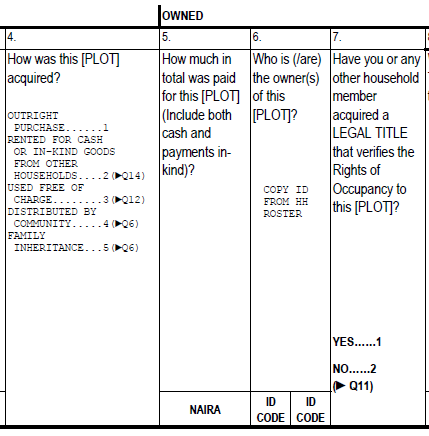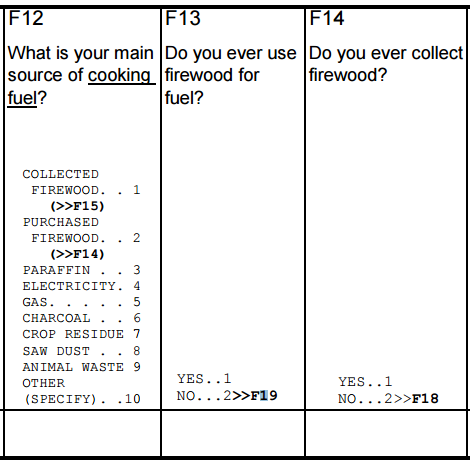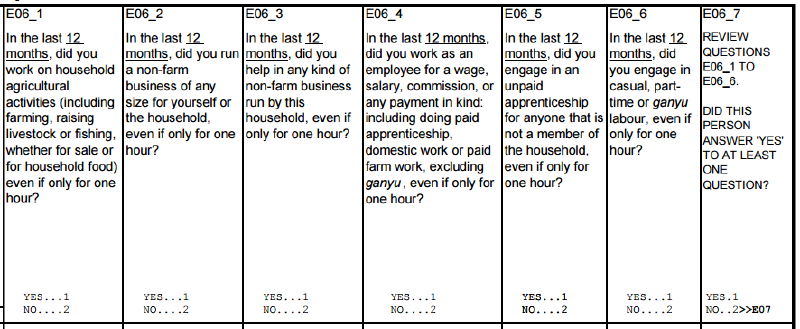Common tasks
The section below lists the common tasks, and the elements of the syntax for accomplishing them.
Comparison to a value
- Relational Operators
- less than, greater than, equal to, etc.
Comparison to a range
- InRange. Checks if the selected answer falls within a range of user-specified values.
Comparison to a list of values
- InList. Checks whether the selected answer is among the set of enumerated values.
- IsNoneOf. Confirms that the selected answer is not among the set of enumerated values.
Count the number of values
- CountValue. Counts the number of times a specified value is recorded as the answer to the set of enumerated questions.
Syntax explained
InRange
Syntax
singleSelect.InRange(a,b)
Description
Checks if the selected answer falls within a range of user-specified values. Returns true if
a ≥ singleSelect ≥ b
. Returns false otherwise.
Example
For numeric questions, InRange was a convenient way to determine whether a value fell within a well-defined interval. For single-select questions, the same is true. But the use case is for identifying the set of ajacent answer options that map to a certain survey behavior, for example a skip.
Consider the set of questions below.

For certain marital statuses, there is a follow-up question. For others, no such follow-up question is administered.
// administer B20 when the household member is married (i.e., answer 1 or 2 to B19)
hh_b19.InRange(1,2)
When answer 1 or 2 is selected in B19, the question B20 is enabled. When any other answer is provided for B19, question B20 is disabled.
InList
Syntax
singleSelect.InList(a,b,c,...)
Description
Check if the selected answer is part of the set of enumerated values. Returns true if
singleSelect ∈ {a,b,c,...}
. Returns false otherwise.
Example 1: Where InRange would also work
See the example in the InRange section above. This could also have been done with InList.
// administer B20 when the household member is married (i.e., answer 1 or 2 to B19 hh_b19.InList(1,2)
When the number of values in a range is small, InList may be roughly as effective a solution as InRange. When the number of values in the range is large, InRange is the better solution.
Example 2: Where InList is the better choice
While InList and InRange may sometimes be used interchangeably, there are moments when InList is the clear choice. See the excerpt below for such an example.

Let’s describe the conditions under which question 6 is answered. If the interviewer records option 1 for question 4, then question 6 is asked. If options 4 or 5 are recorded, then question 6 is also administered. Otherwise, the interviewer skips to later questions. To summarize, then, question 6 is enabled when options 1, 4, or 5 is recorded. Or, in code:
// enable question 6 when answer is 1, 4, or 5 is chosen for question 4
ag_q4.InList(1,4,5)
IsNoneOf
Syntax
singleSelect.IsNoneOf(a,b,c,...)
Description
Checks that the selected answer is none of the listed values–in other words, is not part of the set of enumerated values. Returns true if
singleSelect ∉ {a,b,c,...}
. Returns false if singleSelect ∈ {a,b,c,…}.
Example
Often, it is easier to say what should not be, rather than what should be. Consider the following example. Follow-up questions about firewood use are asked only if the household does not use firewood as its main source of cooking fuel.

Certainly, one could write the following enablement condition, identifying which answers lead the interviewer to F13.
// enable F13 if one of these answers selected for F12
self.InRange(3,10)
However, it may be more efficient, more compact, and more readable to write which answers will disable F13.
// enable F13 if no firewood option is chosen for F12
self.IsNoneOf(1,2)
CountValue
Syntax
CountValue(a,singleSelect1,singleSelect2,...)
Description
Counts the number of times the value a is selected in the set of enumerated variables (i.e., singleSelect1, singleSelect2, ….). Returns the number of occurrences (as a long). Returns 0 if the value does not appear. Returns 0 if all variables are null or disabled.
Example: Number of yes answers
Sometimes, survey sections have not one but several screening questions. Typically, in that cases, the interviewer is asked to verify whether there is at least one “yes” answer in the series of screening questions.
Consider the labor module example below. Each household member is asked a series of yes/no screening questions (i.e., E06_1 - E06_6). If there is at least one “yes” answer, then more detailed labor questions are administered. If there is not a single “yes” answer, then interviewer administers a different set of questions.

To implement this enablement condition, we can use the CountValue() method.
/* enable the questions after E06_6 if there is at least 1 "yes" answer */
// count the number of "yes" answers, and verify that it is greater than 0
CountValue(1,hh_e06_1,hh_e06_2,hh_e06_3,hh_e06_4,hh_e06_5,hh_e06_6) > 0
